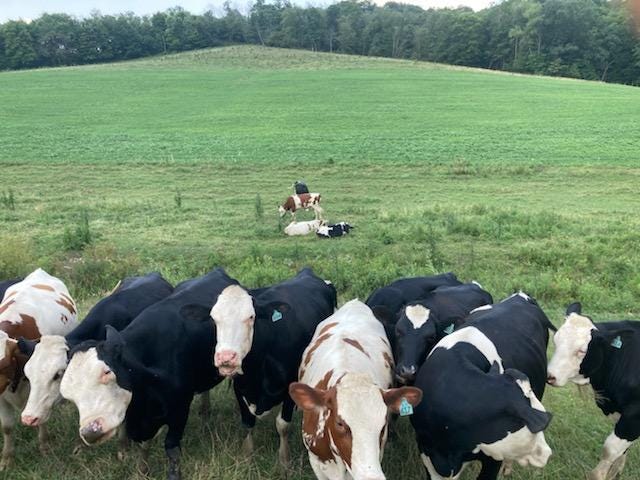November 25, 2025 | 18:45 GMT +7
November 25, 2025 | 18:45 GMT +7
Hotline: 0913.378.918
November 25, 2025 | 18:45 GMT +7
Hotline: 0913.378.918

Starting in 1999, the concept pioneers tried, and discarded, multiple breeds of cows to reach the ideal prototype animals. Photo: Glenn Carlisle
Glenn Carlisle, of Carlisle Dairy + Forage Consulting, LLC, of Dover, is among those promoting planned three-way cross breeding of dairy cattle to allow farmers to get more income while using fewer resources to produce milk.
"Beef, poultry and swine have utilized three-way hybrids ever since I can remember," Carlisle said, citing these benefits:
"The concept was developed and extensively researched by a group of California dairymen along with an innovative cow breeding expert named Mike Osmundson," Carlisle said. "Starting in 1999, the concept pioneers tried, and discarded, multiple breeds of cows to reach the ideal prototype animals."
He said black-and-white, pure-bred Holstein-Friesian cows have dominated world milk production for over 100 years. Along the way, some strengths were shed to achieve higher production. Lower productive lifetimes with higher health intervention costs, and an issue with in-breeding closely related cows, have inadvertently caused some issues that cost the farmers significant losses of income.
Talk about inbreeding
How inbred are they?
Carlisle noted that 90% of purebred Holsteins are descended from six sires.
Researchers settled on two breeds to complement the Holstein drive to produce large amounts of milk. They are the Montebeliarde from France, a durable, fertile and low- input breed, and the VikingRed, a hardy cow developed in the Nordic countries which has minimal health issues and high fertility.
"The resulting off-spring are an interesting variety of color patterns, but uniform in size, and easily achieve the desired goals." Carlisle said. The red coats of the parents show up in succeeding generations. They are shorter in stature than pure U.S. Holsteins.
Carlisle said these multi-colored cows produce milk with denser milk solids: butterfat, protein and other solids.
"As human fluid milk trends continue to drop — and butter, cheese, yogurt and other products consumers want are going sharply upwards in demand — it makes sense in many ways," Carlisle said. "Since a dairyman’s payment for his milk is based on the percentage of these solids in his milk – more income can be produced without increasing the volume of milk transported."
More profit, less stress
The cross-bred cows are more profitable than their Holstein herdmates, according to the report from a 10-year study with high-performance Minnesota dairy herds. The study was conducted by three researchers from the University of Minnesota. The final results of the study were presented in a July 2019 conference in the Netherlands.
"The concept – now called ProCROSS and marketed in the USA by Creative Genetics of California and world-wide — is proving to be a huge financial boon to U.S. farming families by decreasing resources used in feed and labor and increased quality of family life with lower stress," Carlisle said. "That is exciting for me as a consultant to our local family owned farms. Better quality of life with less stress. Who wouldn’t like that?"
(Timesreporter)

(VAN) Brazil's COP30 presidency pushed through a compromise climate deal on Saturday that would boost finance for poor nations coping with global warming but that omitted any mention of the fossil fuels driving it.

(VAN) Poultry farmers in the UK have been warned that they could face one of the worst winters yet for bird flu.

(VAN) Prices of main-crop paddy have risen sharply, with jasmine rice hitting 16,100 baht per tonne — the highest level in years.

(VAN) In Brazil, FAO unveiled a series of reports and initiatives showing how sustainable agrifood systems are a solution to the climate crisis.

(VAN) With names like neodymium and dysprosium, rare-earth elements sound exotic — and their perceived scarcity has only added to the mystique.

(VAN) In a new study published in Trends in Biotechnology, researchers used a gene-editing technology called CRISPR to increase a fungus's production efficiency and cut its production-related environmental impact by as much as 61%- all without adding any foreign DNA.

(VAN) A top official in Beijing’s Cop delegation says China is committed to clean energy – but US’s absence is a problem.